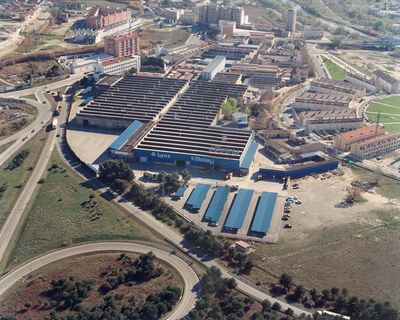Balay S.A.
In 1947, entrepreneurs Esteban Bayona and José Maria Lairla founded a company to produce electrical appliances in the Spanish city of Zaragoza. The company name was coined from their surnames – Bayona and Lairla – to become Balay. Powered on by quick success and the boom in the home appliance market, the company began to produce electric cookers and washing machines in the 1950s.[1] Strong sales allowed the company to move to a new 3,000 m2 factory building in the rural district of Montañana, located north of Zaragoza, in 1956. A second factory followed in 1979 in La Cartuja on the outskirts of Zaragoza. Balay continued to grow and by the early 1980s was one of the leading companies in the sector in Spain.
As a consequence of the economic crisis and saturation of the domestic market, employment fell by almost 50 percent in the Spanish home appliance sector between the years of 1980 and 1987. Thanks to restructuring measures, Balay was nationalized in 1980 and merged with the home appliance manufacturer Safel to form the Safel-Balay Group. Once the Spanish home appliance market had stabilized, the Spanish Government decided to reprivatize the Group at the end of 1988.
BSH offered a way out of the crisis
BSH[2] CEO, Dr. Herbert Wörner, delivered the opening address at the BSH company conference in Munich in June 1989, where he outlined the strategy for the coming 1990s: "...to develop BSHG from a company with a heavy bias on the home market (...) to a true European white goods producer." The majority stake in Balay and Safel in December 1988 represented a significant step already toward achieving this objective. BSH thus acquired the 24 percent market share held by the two Spanish manufacturers in their home country. At a European level, a market share of 12 percent was achieved, thus making BSH the second largest manufacturer of home appliances.[3]
Kompetenz für Induktionstechnologie
Angesichts der hohen Sättigungsraten in den traditionellen Produktbereichen ist das Haushaltsgerätegeschäft Anfang der 1990er Jahre zum größten Teil von Ersatzbedarf geprägt. Um sich von der Konkurrenz abzusetzen, ist Innovation gefragt. Von besonderem Interesse für die BSH ist daher das Know-How zur Induktionstechnologie das die Spanier mitbringen. Die Region um Zaragoza gilt seit 1980 als das „Silicon Valley“ der Induktionstechnik.[4] Ab 1981 besteht zwischen der Universität von Zaragoza und Balay eine Kooperation zur Entwicklung elektromagnetischer Kochfelder. Als Ergebnis dieser Zusammenarbeit werden auf der Internationalen Messe Domotechnica 1987 in Köln erste marktreife Prototypen präsentiert. Die BSH baut die Balay Entwicklungsabteilung in den folgenden Jahren zum Kompetenzzentrum für Induktionstechnologie aus. Das erste von den Ingenieuren in Zaragoza entwickelte BSH-Induktionskochfeld geht 1990 in Serie.[5]
Seit 1998 ist Balay hundertprozentige Tochter der BSH. Im gleichen Jahr erwirbt die BSH auch die Rechte an der spanischen Hausgeräte Marke UFESA. Als Local Hero-Marke für den spanischen Markt ist Balay heute, neben den BSH-Hauptmarken Bosch und Siemens, ein wichtiges Standbein der spanischen Dachgesellschaft BSH Electrodomesticos Espana (BSH-E). Auch im neuen Jahrtausend kann die BSH-E ihre regionale Marktführerschaft verteidigen. Der Fertigungsverbund in Spanien umfasst heute sechs Standorte mit insgesamt ca. 4.000 Mitarbeitern in denen Produkte der Marken Balay, Bosch, Siemens, Gaggenau und NEFF produziert werden.
2022 feiert die Marke Balay ihr 75. Jubiläum.
Einzelnachweise
- ↑ BSH Corporate Archives, A05-0024, inform August 2001, page 25.
- ↑ BSH was founded in 1967 as Bosch-Siemens Hausgeräte GmbH - BSHG for short. In 1998, the name was changed to BSH Bosch und Siemens Hausgeräte GmbH, with the short form BSH. Since the sale of the Siemens shares in BSH to Robert Bosch GmbH the company’s name is now BSH Hausgeräte GmbH, but still BSH for short.
- ↑ BSH Corporate Archives, A05-0012, inform 02/1989, from page 2.
- ↑ BSH-Konzernarchiv, A01-0022, Geschäftsbericht 2004, S. 29.
- ↑ BSH-Konzernarchiv, A05-0034, inform 01/2011, Jg. 34, S. 20.
